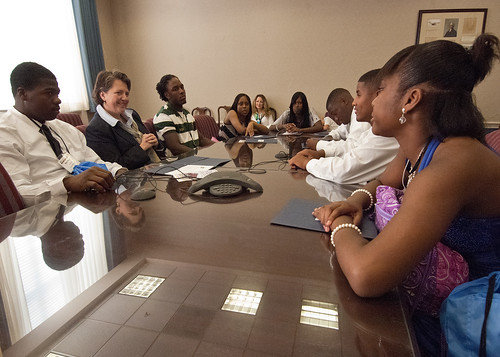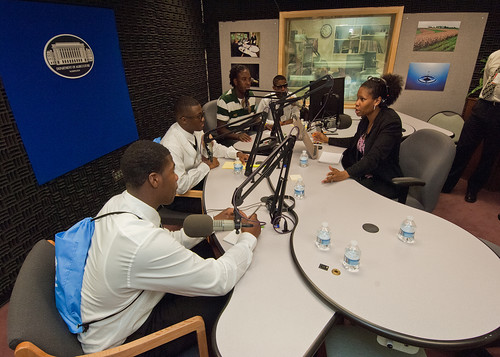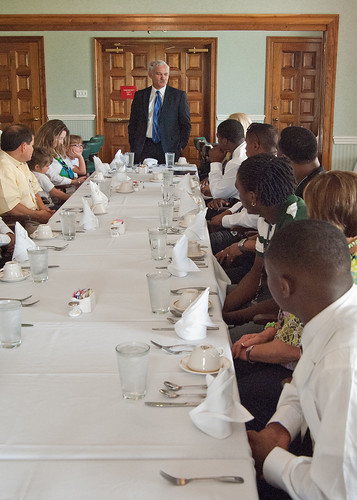
It wasn’t supposed to happen.
There wasn’t supposed to be an agriculture curriculum. There wasn’t supposed to be an instructor. And there definitely wasn’t any money to send seven African-American students from one of the smallest and lowest income towns in Texas to Washington, D.C., to speak with high-level USDA officials.
But it happened.
High school seniors from the Calvert Independent School District received an all-expense paid senior trip — compliments of a local bank — to the Nation’s Capital where they met with USDA Deputy Secretary Kathleen Merrigan, ate lunch with Farm and Foreign Agriculture Acting Under Secretary Michael Scuse and discussed opportunities in agriculture with USDA employees.
“Words will never be able to express how fortunate and excited we are to be given this opportunity,” said Shameka Grimes, senior class president and student council vice president. “Many of us have never been outside the state of Texas so this is a once in a lifetime opportunity,” she said.
The town of Calvert in Robertson County is 3.9 square miles of land with a history of agriculture. Most of the 1,351 residents that populate Calvert are of African-American or Hispanic descent and the median income is $25,657. The 2011 Calvert High School graduating class has 15 students and an agriculture curriculum that was almost canceled. During the student’s junior year, the agriculture instructor for Calvert accepted a position at another school. A replacement teacher could not be found before the start of the school year, leaving the students with no agriculture program.
That’s when Terri Trevino, a farm loan manager with the Texas Farm Service Agency, stepped in to make sure the program moved forward.
“We didn’t want to see the program suspended,” said Trevino. A resident of Robertson County for 12 years, Trevino has always taken an interest in the Calvert community. “When I first came it was almost a ghost town with the exception of a local bank and school. I have always been drawn to that community and collecting snippets of information.”
It was her babysitter that alerted her to the dying agriculture curriculum at Calvert. That’s when Trevino decided it was her turn to get involved.
She created a curriculum, secured volunteers from Texas A&M, local businesses and the Farm Service Agency to teach the courses and was instrumental in getting Herman Duhr, president of Enterprise Bank and one of the instructors, to pay for the students to travel to Washington, D.C. to visit USDA and learn about policy and career options in agriculture.

“Ag is more than just livestock and meat inspections. There are a lot of different aspects to every job,” Susan Carter told the group of seniors. A reporter and producer with the USDA Creative Media and Production Center, Carter toured the group through the television and radio studios, giving them a chance to create a mock television production and give radio interviews.
For JaMarcus Ashley, broadcasting is his aspiration. Although he will be attending junior college in the fall to become a registered nurse, ultimately, he wants to be on the flat screen. “I want to be on TV. I could do a commercial about agriculture, anything. I just want to be on TV,” he said.
Grimes has a different take on it. “It’s interesting to know that it’s not just about farming, but there are other aspects [of agriculture] such as the loans,” said Grimes. “But personally, I’m interested in the livestock and seeing them grow. I like to get down and dirty.”
She added that the agriculture courses have taught her a lot of life skills. “It taught me responsibility because you have to feed those animals and care for them and be dedicated to them,” said Grimes.
JaMarion Ramirez raised a lamb and a pig as part of his Future Farmers of America project, but it was money that piqued his interest when the students met with Deputy Secretary Merrigan.
“I’d like to know what you all do with a $149 billion dollar budget?” asked Ramirez, who will be joining the Air Force after graduation.
“It starts out with that, but when we are finished it is a whole lot less,” said Merrigan. Sandwiched in the middle of the group as they sat around a conference table in the USDA Whitten Building, Merrigan added that 74 percent of that budget goes toward food and nutrition such as the school lunch programs, food stamps and the Women, Infant and Children program.
While showing off her newly acquired boots purchased during a recent trip to Texas, Merrigan, a University of Texas graduate, encouraged the students to read the newspaper and become informed citizens. “Everyone has an opinion about something, but it’s not backed up by any real facts. Read and keep yourself informed so that you know the facts and what is happening,” she said. “It makes you a better person and a more interesting person to talk to.”
Further encouragement was given by Farm and Foreign Agriculture Acting Under Secretary Scuse during lunch in the Secretary’s dining room and through a career opportunity session where former interns spoke about their journey from internship to career positions within USDA.
“I enjoyed my time here,” said La’Kendra Crowley. Although her goal is to go to cosmetology school and own a beauty shop, La’Kendra said this trip gave her valuable experience. “I’m interested in being in the building and seeing how people do stuff,” she said. “Taking the [agriculture] courses that Mrs. Trevino set up was definitely worth it.”
To listen to a radio address about the visit, please visit our website.

